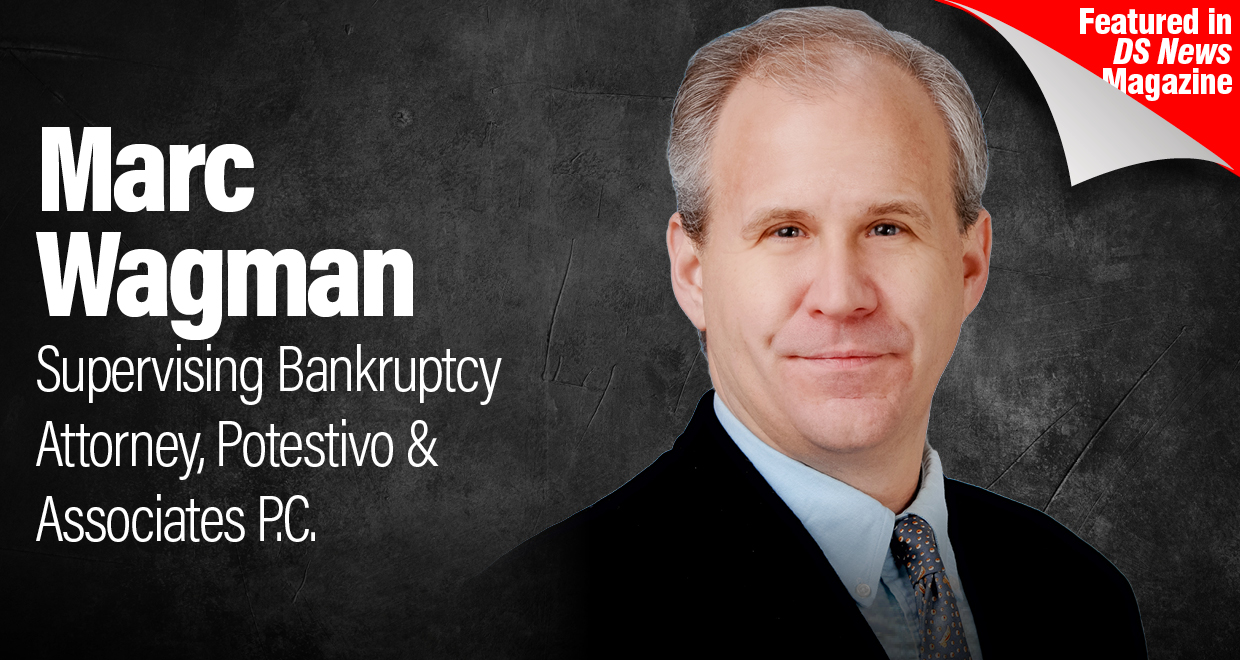 Before joining Potestivo, Marc Wagman worked at a variety of law firms in the Chicago area, including his own private practice that focused on creditors’ rights and consumer financial issues. He brings over 14 years’ bankruptcy experience in creditor and debtor representation, adversary lawsuits, examinations, and a plethora of motions and evidentiary hearings. Wagman is a member of the Northern District of Illinois Trial Bar and belongs to the American Bar Association, the Illinois Bar Association, and the DuPage County Bar Association. Wagman spoke with DS News about the challenges faced by attorneys working in the bankruptcy space and how technology is helping them streamline their processes and systems.
Before joining Potestivo, Marc Wagman worked at a variety of law firms in the Chicago area, including his own private practice that focused on creditors’ rights and consumer financial issues. He brings over 14 years’ bankruptcy experience in creditor and debtor representation, adversary lawsuits, examinations, and a plethora of motions and evidentiary hearings. Wagman is a member of the Northern District of Illinois Trial Bar and belongs to the American Bar Association, the Illinois Bar Association, and the DuPage County Bar Association. Wagman spoke with DS News about the challenges faced by attorneys working in the bankruptcy space and how technology is helping them streamline their processes and systems.
What are the trends you see at play in the bankruptcy sector right now?
Bankruptcy filings are currently down to their lowest level in over 10 years. With a reversal in the economy, however, filings are projected to increase in the future. Normally, bankruptcy filings lag behind the economy in actual numbers as most people wait to file a bankruptcy. Serious delinquencies for mortgages are also on the decline.
What are the biggest challenges for firms operating in the current financial landscape, and how can they overcome them?
Meeting the short deadlines required for proofs of claims and filing them accurately are among the biggest challenges that bankruptcy firms face in the current environment. A proof of claim for a mortgage company has become significantly more challenging, and the deadline is now only 70 days. The lender is required to file a 410 (a) form (by Excel spreadsheet) that documents the entire history of the loan since a default occurred, and that can be daunting in some cases since a default can occur over a long period of time. With a short deadline, a mortgage company must have its proof of claim on file to be paid by the trustee.
However, streamlining the law firm’s processes can help, as can using technology to their advantage in order to minimize the costs associated with such filings. It also helps to effectively represent the client’s interests.
How should firms be working to evolve or streamline their processes?
Today, the internet is used by law firms to more effectively represent clients, and to streamline their processes. One can search for nearly anything on the internet, such as a bankruptcy filing, a court docket, the recorder’s website, Circuit Courts, and numerous public records. New computer programs are also allowing law firms to delegate steps and go through their process so that things are not missed.
Could you tell us about any recent important litigation or regulations impacting bankruptcy law that our readers should be aware of?
Litigation regarding notices of post-petition fees has increased as debtor’s attorneys are now challenging fees and costs more often. Additionally, once a loan is reinstated, bankruptcy rule 3002 now requires a lender to state that the loan is either current or not current, along with an itemization of any charged which may be challenged. Of course, violating bankruptcies’ automatic stay is one of the biggest risks faced by any lender or creditor.
However, courts are looking much closer at creditors fee’s within a bankruptcy. One trend that has increased significantly over the past few years is for debtor’s attorneys to look at the fees that a firm is charging to the debtor too.
Litigation has also increased with regards to the discharge injunction, notice of reinstatement by the trustee in a Chapter 13, regarding fees and costs incurred during the bankruptcy, and an increase in damage awards for violations.
What are the biggest challenges of interacting with borrowers who are undergoing bankruptcy or foreclosure proceedings?
In bankruptcy, a creditor’s counsel cannot speak with a represented borrower, so most of the communication goes through their attorney. In foreclosure, borrowers are now more aware of the hardship programs available and the possibility of loan modifications, forbearance agreements, and other options that may help them. The biggest challenge for borrowers is making ends meet, as statistics show that a significant number of Americans cannot afford a $600 emergency. This could cause significant hardship on them and go so far as to put a borrower into default, or possibly into bankruptcy or foreclosure.
Are there any technological or process innovations that are significantly affecting the way you do business?
Technology has certainly changed the way everything is done today. When I started as an attorney, files were actual paper. Now the files are electronic, and one must safeguard their computers and information much more vigorously. Electronic filing is now standard with most courts, and one does not need to bring paper to the courthouse. However, one must be careful to redact personal information from any filing as regulations protect against personal information being filing in the public records.

 DSNews The homepage of the servicing industry
DSNews The homepage of the servicing industry









